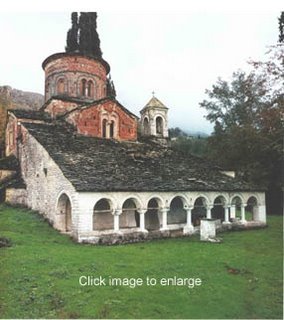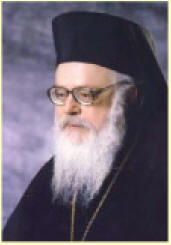

THE CHURCH OF ALBANIA
HISTORY AND SPIRITUAL TRADITION
Written by
His Beatitude Anastasios
Archbishop of Tirana, Durrës
and All Albania
Part 1: From Apostolic Times to 731
The region occupied by what is now Albania stretches along the north coast of the lonian Sea and the south coast of the Adriatic, and lies inland along the axis of the western section of the axis formed by the Egnatian Way. It has been directly involved in the political and intellectual ferment of three successive empires - Roman, Byzantine, and Ottoman. At the same time it has been a target for barbarian attacks and looting by various peoples (Huns, Goths, Normans, Serbs, Bulgars, Venetians, and others) intent on penetrating into its territory. Its most fundamental metropolitan centres have always been multi-ethnic in composition, with Greek, Illyrian, and Roman living side by side and with various other elements in time of invasion. On the basis of the ecclesiastical affiliation of the provinces of modern Albania, we can disengage five chronological periods. There are firstly the days of the apostles, up to the year 731, when this region was subordinate to the self-governing church of East Illyricum, under the Roman vicariate of Thessalonike. The second period runs from 731 to the eleventh century: the region was subordinate to the Patriarchate of Constantinople. The third period runs from the eleventh century to 1767: most of the sees were subject to the autocephalous archbishopric of Ohrid. The fourth period is from 1767 to 1937: subject to the Patriarchate of Constantinople. In the last period, from 1937 onwards, the church of Albania is autocephalous.
From Apostolic times to 731
Writing from Corinth to the Romans, in 55-57 A. D., the apostle Paul records that he was acting with holy zeal "so that from Jerusalem, and round about unto Illyricum, I have fully preached the gospel of Christ" (Romans xv. 18-19). By "unto Illyricum" he probably meant that he included Illyricum, which was in the first century A.D. a province of Macedonia. In the light of his next words -"Yea, so have I striven to preach the gospel, not where Christ was named, lest I should build upon another man's foundation"- we would be justified in supposing that it was the apostle Paul, either in person or through his close associates, who first planted the seed of the Gospel in the geographical region we are looking at. That he was at Nikopolis, not much south of present-day Albania, is incontestable (Titus iii. 12). So too is the missionary work of his close associate Titus in Dalmatia, a little to the north of present-day Albania (II Timothy iv. 10). One early tradition named the apostle to this region as Kaisar (or Kaisarios), one of seventy apostles; and another reconciled the two versions by making Paul establish Kaisar as first bishop of Dyrrachion (Durrës).
Clearer evidence of the presence of a church community at Dyrrachion is provided by the witness of bishop Asteios (or Astios) in 98 A.D. The reference in the Orthodox menologion is as follows. "July 6th. Saint Asteios, bishop of Dyrrachion, anointed with honey and stung by bees, perfects his life upon the cross". The day after, July 7th, is the feast in commemoration of Saint Peregrinus and the other saints, all of Latin origin, who died with him -Lucian, Pompey, Hesychius, Papius, Saturninus, and Germanus- when they were drowned in the sea by the governor of Dyrrachion, Agricola.
Dyrrachion, the ancient Kerkyrean colony of Epidamnos, was a main harbour for the Adriatic. It was the Romans' gateway to the Balkans and, along the Egnatian Way, to Thessalonike and Constantinople. At this crossroads it was natural that a cosmopolitan church should spring up in the first Christian centuries. This church was constantly plagued by invasions, earthquakes, and fires, but it never ceased to renew and reorganize itself. When the Roman Empire split into East and West on the death of Theodosios I in 395, what is now Albania became subject to the Eastern provinces. Until the time of Constantine the Great, the region had been dependent, politically and ecclesiastically, on Rome. Afterwards, it belonged only politically to Constantinople, while ecclesiastically the old situation did not change, until the year 731.
The whole of Eastern Illyricum was a self-governed church under the supreme supervision of Rome via the vicariate of Thessalonike. Of the vicariate's nine bishops, the metropolitan of Dyrrachion ranked fifth. In Hierocles' "Synekdemos", a sixth-century text, several towns that today belong geographically to Albania are mentioned by name. In New Epirus there are: Dyrrachion, Skampia (Elbasan), Apollonia, Byllis, Amantia, Poulcheriopolis (Berat), Aulon (Vlora), Listron, and Scipon. In Old Epirus there are: Euroia, Phoinike, Adrianopolis, Anchiasmos, and Bouthrotos (Butrinto). [There are several variants in the names of towns and sees as given by the sources]. Further south, from 429 onwards, was the see of Dryinopolis, the seat of which was originally somewhere near Korytsa of Dropolis, then later (558) at Episkope. Episcopal sees often had to move because of military and political events in the region.
Historical information about this period is very limited. Additional evidence comes from archaeological finds and -a valuable piece in the mosaic- names of some saints and bishops. But these are not enough for us to reconstruct the complete mosaic of local church history. Christian tombs found in a stoa outside the walls of Bouthrotos, and probably dating to the second century, are our earliest indication of the presence of a Christian community in what is now Albania. Early Christian basilicas have been discovered in various places. They are mostly from the fifth or sixth century, and their dimensions show that they must have served sizable Christian communities, thus standing as important witnesses to the flourishing Christianity of this area.
Our region is drenched in the blood of saints. They have included Eleutherios, "bishop of Aulon and Illyricum", martyred in 120; his mother "Anthia", Donatos, and Therinos, all martyred at Bouthrotos in 250; Danax (third century); Isauros, Basil, Innocent, Felix, Hermias and Peregrinus (all from Apollonia, in the third century); Tryphon (from Sekista in Berat, in 313); Donatos, bishop of Euroia (in 387). The names of a handful of bishops are known from the proceedings of Oecumenical Synods. Eucharios bishop of Dyrrachion and Felix "bishop of the towns of Apollonia and Belis" were at the Third Oecumenical Synod (431). Eusebios "of Apollonia in New Epirus", "Peter of Echineos" in the series of bishops from New Epirus, Luke, Pelegrinus of Phoinike, and Claudios (or Kladeos) of Anchiasmos all took part in the Fourth Oecumenical Synod (451). Bishop Syssinios was present at the Synod in Trullo (691/692). There are also other mentions of bishops: Hypatios, at the local Synod in Epirus in 516; Eutychios (or Eustochios) (449-451) and Constantine (523-529); Valerian, bishop of Phoenike in the reign of the Emperor Leontios; Philip (516) and Eustathios (586).
George A. Christopoulos, THE SPLENDOUR OF ORTHODOXY. 2000 Years – History • Monuments • Art , Vol. II - Patriarchates and Autocephalous Churches - , Ekdotike Athenon, Athens, 2000.
No comments:
Post a Comment